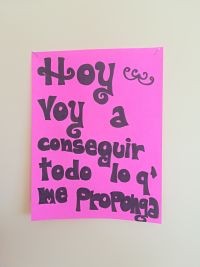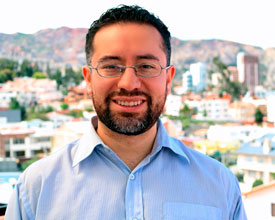
The experience of "Community Treatment" in El Alto city
The experience of "Community Treatment" in El Alto city
Photograph taken in one of the rooms of the "House of Tenderness", a place where Munasim Kullakita Foundation provides housing for young women over 18 years, who managed to get out of the dynamic of commercial sexual violence, where they continue their process.
The "Community Treatment" is a way of working with the populations in the situation of exclusion and social marginality: "El Tratamiento con Base Comunitaria (TBC) es entendido como un conjunto de procesos en el cual se articulan actores, conceptos, acciones, instrumentos, prácticas y recursos organizados cuyo objetivo es promover el mejoramiento de las condiciones de vida de las personas, los grupos, las redes y las comunidades vinculadas al proceso de exclusión social grave"[1]
This methodology is based on the ECO2 model: “El nombre del modelo ECO2 se construyó como un juego de palabras, a partir de algunos de sus elementos esenciales: Epistemología de la Complejidad (ECO), Ética y Comunitaria (ECO), por lo tanto ECO2. La palabra ECO hace referencia también a la raíz griega que significa ‘Casa’ y está en la etimología de Ecumenismo y Ecología, aludiendo a los procesos de inclusión social que promueve el modelo.”[2]
In Bolivia, particularly in El Alto city, Munasim Kullakita Foundation implements this methodology through different devices aimed, in the first instance, at the reduction of damage in populations in situation from social suffering, and in a subsequent stage to the gradual and systematic restitution of rights.
This foundation has a project called "Drop in center", which consists of “un centro de bajo umbral… que tiene como finalidad el apoyar y orientar a personas o grupos de la comunidad que viven situaciones de marginalidad social, sin que en el interior del mismo se repita o reproduzca el mismo proceso”[3]
Oriented to adolescents and young people in street situation, with problems of psychoactive substance consume, the "Drop in center" allows this population to remain at least for a while in a safe space, where through a code of coexistence these adolescents and young people compromise to: not to consume any type of substance, not to fight, not to steal, and they also have availability of basic care, such as laundry, shower, food and basic health care; this is a damage reduction device. A similar project, whose target population is girls and adolescents in situations or at risk of commercial sexual violence, is the "Open Space" project that also allows facing a process of harm reduction and reflection with this population.
Other devices with which the Foundation operates are oriented towards the restitution of rights, although these are combined with harm reduction, they also involve more sustained processes, involve individualized accompaniment, and specific objectives regarding the restitution of rights, For example, obtaining identity documents (right to identity), recovering family ties (right to family), diagnosis and treatment of health conditions (right to health), reintegration into formal educational processes (right to education), among others.
But the work of recovery of this population does not end there, unfortunately the system of protection at the municipal, departmental and national level has a huge gap: that from the age of 19 the young people who have had a healing process and of rehabilitation in Munasim Kullakita Foundation (and in general in any institution that works with children and adolescents) are left unprotected again, since there is no instance that continues these processes as of the age of majority, the State does not does not even nominally take responsibility this population.
Seeing this situation, the Foundation has implemented projects of technical training, employability, entrepreneurship, which at least in part helps young people over 18 years old to begin to fend for themselves and socially and economically reinsert themselves into the community, this process is not easy, and it has a high drop-out rate, not only in the specific case of the Munasim Kullakita Foundation, but in all the projects and interventions that work with populations in situations of vulnerability, exclusion and social marginality.
The fundamental aspect of the Community Treatment model with which Munasim Kullakita Foundation works is the work in community, which is materialized in the creation of community networks that actively participate in the solution of the problems of marginality and social exclusion: “Un resultado bien documentado de múltiples y diversas investigaciones es que las redes sociales juegan un papel fundamental en los estados de salud/bienestar o enfermedad/malestar de las personas”[4]
In the same way that the venom of vipers is used to elaborate the antidotes for its effects, the community –which is one of the main factors that generates social marginality, since it is the one that judges and excludes– is the vital element to recover these populations of their situation of extreme vulnerability, in this way the community becomes a co-responsible for the recovery and reintegration of these adolescents and young people and becomes in a positive reference, in an alternative to the negative networks that were the ones that in first instance introduced these children and adolescents in the violence dynamics that are reproduced in the street, and often in other environments: in schools and in the same homes.
As part of the extended community of these children and adolescents who live and/or work in the streets, of these girls and adolescents in situation of commercial sexual violence or at risk of falling into this dynamic, we who see the world through a monitor or a "display", we have the obligation to reflect on our co-responsibility in this reality, which is neither as distant nor as foreign as we imagine, and to understand some simple details, for example that the pornography and sexual services market, not would have so much offer if there was not such an expanded demand, this demand that, incidentally, in most cases comes from men who see the world through a monitor or a “display”.
[1] Fundación Convivir (s/n); “Tratamiento Comunitario”; https://convivir.org/areas/tratamiento-comunitario/
[2] Machin, Juan (2010); “Modelo ECO2: redes sociales, complejidad y sufrimiento social”; REDES- Revista hispana para el análisis de redes sociales Vol.18, #12, Junio 2010; http://revista-redes.rediris.es/html-vol18/vol18_12.htm
[3] Munasim Kullakita (s/n); “Programa de Tratamiento Comunitario”; https://www.munasimkullakita.org/programas/programa-de-tratamiento-comunitario.html

